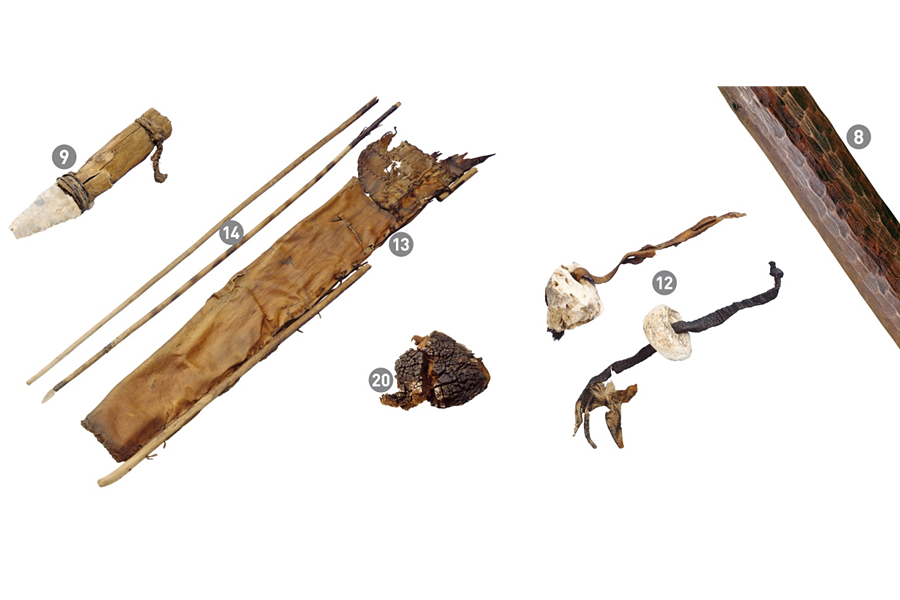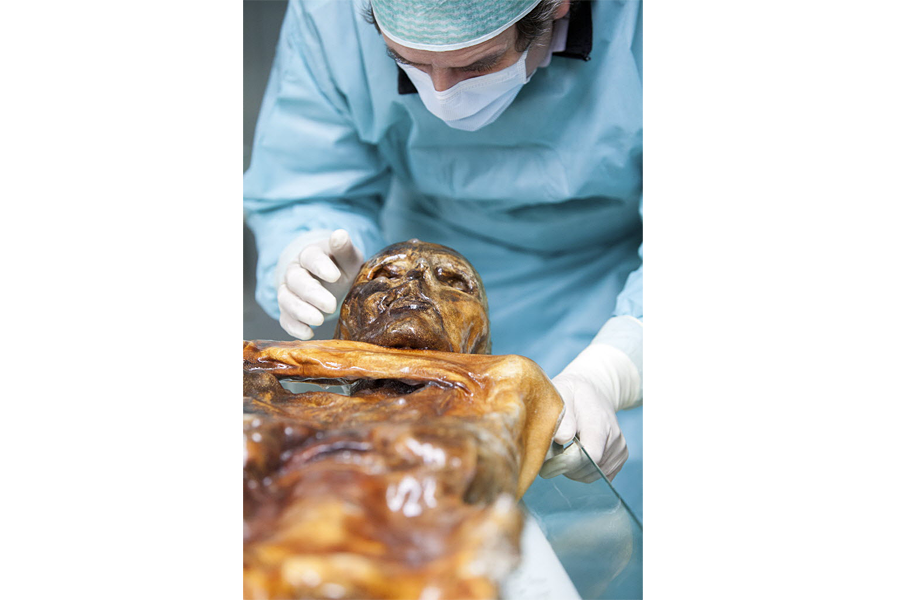Frozen fashion: Decoding Ötzi the Iceman's wardrobe
An outfit can tell a lot about somebody – particularly if that person died 5,300 years ago.
Ötzi the Iceman, a natural mummy discovered frozen in the Ötztal Alps in Italy, has offered scientists a broad variety of clues into the lives of Copper Age Europeans since its discovery a quarter century ago. And now researchers know what leathers and furs the mysterious man wore.
But the investigation wasn't just to see if the famous mummy was fashion-forward. Knowing which animal skins Ötzi wore is another way to fill in the blanks in pre-historians' picture of Copper Age Europe.
"Most of the clothes were composed of cattle, sheep, and goat," says study lead author Niall J. O’Sullivan, a PhD candidate at University College Dublin and the EURAC-Institute for Mummies and the Iceman in Italy.
"This affirms previous observations about the Iceman," he tells The Christian Science Monitor, "that he was indeed an agro-pastoralist."
But not all of Ötzi's clothes were from domesticated animals. He also used brown bear furs and roe deer hide.
"The choices that Copper Age people made with respect to animals exploitation were likely dependent on availability, necessity, functionality and symbolism," the researchers write in a paper published Thursday in the journal Scientific Reports.
The mix of domestic and wild animals used illustrate that diversity of utility and dynamics in Ötzi's society. Although farming would have been the dominant way of life, the Iceman and his peers also hunted for food and supplies.
This "gives insight into their daily life," writes Johannes A. Lenstra, editor-in-chief of Animal Genetics and a professor at Utrecht University, who was not part of the study, in an email to the Monitor. "They had to cope!"
Scientists have poked and prodded Ötzi since he was discovered by two hikers in 1991. They know what his last meal was, how he was murdered, and who his living relatives are.
But previous analysis of his clothing was limited because the tanning process, preservation, and subsequent scientific analyses had made the source animals for the leathers and furs difficult to identify.
So Mr. O'Sullivan and his colleagues turned to DNA to identify the species covering Ötzi's body.
Ötzi wore a full outfit when he died, likely to keep him warm in the chilly mountains. A furry hat sat atop his head, straw-stuffed shoes were on his feet, and he wore leggings, a loincloth, and a coat.
The team found that the Iceman's shoes were laced up with strings made of cattle leather, while his loincloth and much of his coat were made of sheep leather.
But his overcoat was a bit of a patchwork. The genetic analysis revealed that this article of clothing was made of both goat and sheep leather. The combination suggests that the Iceman pieced together whatever hides he had available, which would have been necessary as the ancient leather likely deteriorated quickly, the researchers write in the new paper.
Ötzi's leggings, however, seem to be a more deliberate choice. Made of the more supple goat leather, they would have been relatively flexible for walking. Or perhaps goat leather was chosen for its "insulating potential," the researchers write.
A set of 4,500-year-old leggings found in the Swiss Alps were also made of goatskin, so perhaps this was a common use for that material.
The Iceman's hat was made from the skin of a brown bear, which Dr. Lenstra suggests could have had symbolic meaning as well as keeping Ötzi's head warm.
"It is imaginable that with a hat of a skin of an intimidating animal you become more intimidating yourself," he suggests.
And perhaps the quiver Ötzi carried his arrows in also had important symbolic meaning, Lenstra says.
The quiver was made from the hide of roe deer, an animal known to be swift.
"If survival depended on hunting with arrows and individual status on your success as marksman, the belief may have been crept in that a quiver made of a fast-running species increases your chance of hitting well the next time," Lenstra says.
The use of roe deer skin has more concrete implications too.
Researchers had found that Ötzi's diet included venison, from a different species: red deer. They had previously assumed the deer leather was that species too, so finding that the quiver was made from a roe deer suggests a more diverse use of wild species.
The leathers Ötzi wore were not from extinct wild animals, but "animals which are all typically observed in alpine Europe today," O'Sullivan says. Furthermore, "the domestic species, the cattle, sheep, and goat, had the same haplogroups of the modern haplogroups of cattle, sheep, and goats which are observed in Europe today."
In other words, these leathers came from well-established populations of domestic animals, not just wild relatives of today's domestic animals, he says.
Although clothes likely weren't all about couture in the Copper Age, understanding Ötzi's attire does help bring human history to life, Lenstra says.
So what will archaeologists thousands of years from now think of life in 2016, based on our fashion sense?








